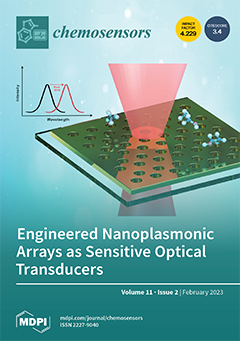Solid-state chemiresistive gas sensors have attracted a lot of researchers’ attention during the last half-century thanks to their ability to detect different gases with high sensitivity, low power consumption, low cost, and high portability. Among the most promising sensitive materials, carbon nanotubes (CNTs)
[...] Read more.
Solid-state chemiresistive gas sensors have attracted a lot of researchers’ attention during the last half-century thanks to their ability to detect different gases with high sensitivity, low power consumption, low cost, and high portability. Among the most promising sensitive materials, carbon nanotubes (CNTs) have attracted a lot of interest due to their large active surface area (in the range of 50–1400 m
2/g, depending on their composition) and the fact that they can operate at room temperature. In this study, single-walled carbon nanotube (SWCNT)-based sensing films were prepared and deposited by spray deposition for the fabrication of gas sensors. For the deposition, various SWCNTs were prepared in deionized water with the addition of specific surfactants, i.e., carboxymethyl cellulose (CMC) and sodium dodecyl sulfate (SDS), which act as dispersing agents to create a suitable ink for deposition. This study aims to elucidate the possible differences in the sensing performance of the fabricated devices due to the use of the two different surfactants. To achieve this goal, all the devices were tested versus ethanol (C
2H
5OH), carbon monoxide (CO), nitrogen dioxide (NO
2), and ammonia (NH
3). The produced devices demonstrated high selectivity towards NH
3 and NO
2. The different sensors, prepared with different deposition thicknesses (from 0.51 nm to 18.41 nm), were tested in dry and wet conditions (40% humidity), highlighting an enhanced response as a function of relative humidity. In addition, sensor performance was evaluated at different working temperatures, showing the best performance when heated up to 150 °C. The best sensing conditions we found were against NO
2, sensors with 10 layers of deposition and an operating temperature of 150 °C; in this condition, sensors showed high responses compared those found in the literature (62.5%—SDS-based and 78.6%—CMC-based). Finally, cross-sensitivity measurements showed how the produced sensors are good candidates for the practical and selective detection of NO
2, even in the presence of the most important interfering gases identified, i.e., NH
3.
Full article





